Australian Paper: Aligning Lean Six Sigma for Sustainability
VerifiedAdded on 2023/06/10
|21
|4882
|354
Report
AI Summary
This report explores how Australian Paper can align Lean Six Sigma (LSS) strategies to address current environmental challenges without compromising business success. It emphasizes the importance of integrating environmental considerations into LSS practices to achieve both efficient production and environmental conservation. The report reviews literature highlighting how LSS inherently reduces environmental impact by eliminating waste, and it suggests specific actions like funding environmental health and safety (EHS) activities, participating in Kaizen events with an environmental focus, and benchmarking against companies that have successfully integrated LSS with environmental efforts. Case studies of firms achieving environmental benefits through LSS are presented, providing practical insights. The report concludes with recommendations for Australian Paper to synergistically combine LSS with environmental stewardship, ensuring a balance between productivity and environmental responsibility.
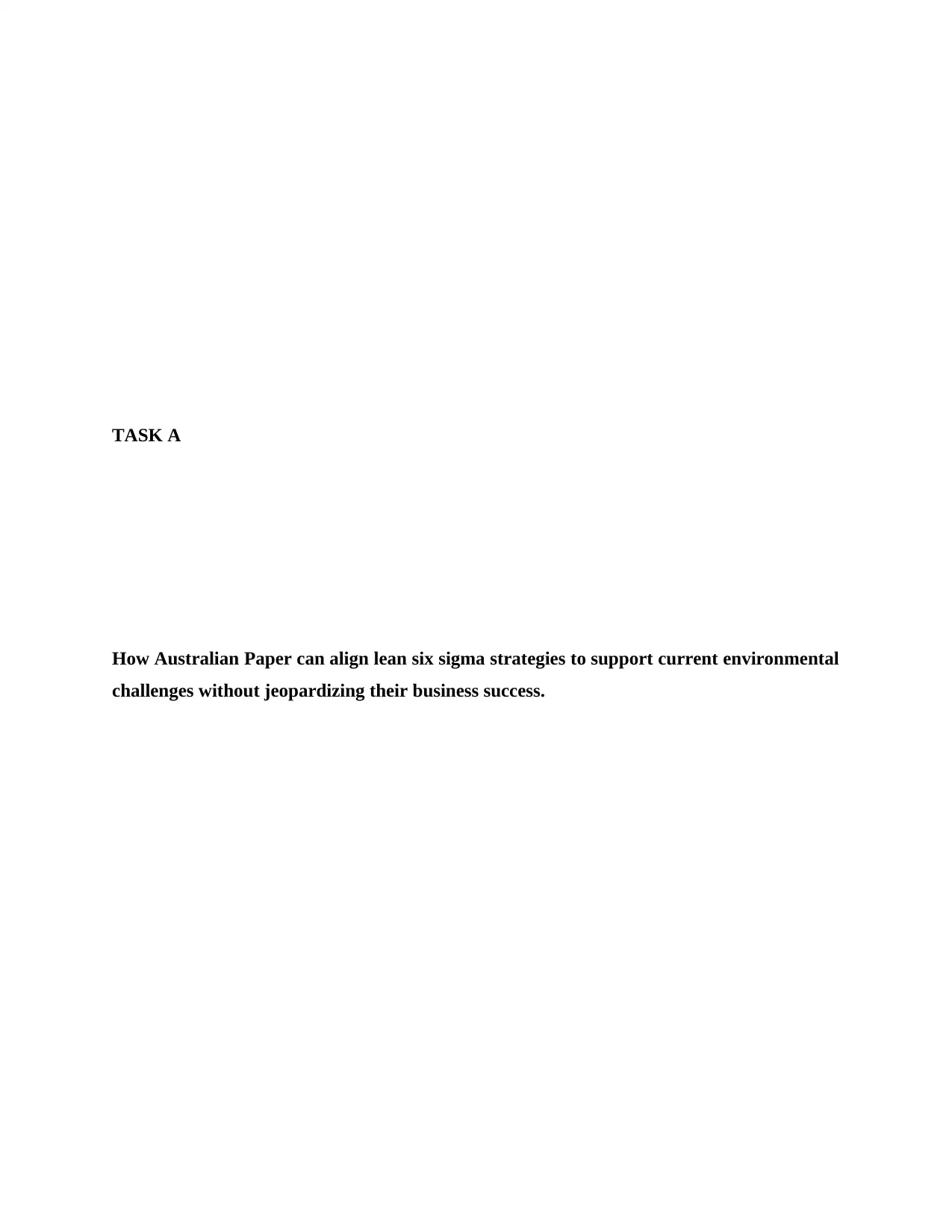
TASK A
How Australian Paper can align lean six sigma strategies to support current environmental
challenges without jeopardizing their business success.
How Australian Paper can align lean six sigma strategies to support current environmental
challenges without jeopardizing their business success.
Paraphrase This Document
Need a fresh take? Get an instant paraphrase of this document with our AI Paraphraser

Table of Contents
Summary.....................................................................................................................................................3
Introduction.................................................................................................................................................4
Literature review and case study.................................................................................................................5
Literature review.....................................................................................................................................5
Case studies of firms who have successfully integrated lean six sigma efforts with the ongoing
environmental efforts..............................................................................................................................9
Findings and recommendations................................................................................................................13
Findings.................................................................................................................................................13
Recommendations.................................................................................................................................13
Conclusion.................................................................................................................................................14
References.................................................................................................................................................16
Conclusion.................................................................................................................................................20
Table 1: The Seven lean wastes...................................................................................................................6
2Adapted from The U.S Environmental Protection Agency's professional guide to lean six sigma.............7
Table 3:Companies who have achieved in environmental efforts...............................................................9
4 Courtesy of U.S Environmental protection Agency.................................................................................12
Summary.....................................................................................................................................................3
Introduction.................................................................................................................................................4
Literature review and case study.................................................................................................................5
Literature review.....................................................................................................................................5
Case studies of firms who have successfully integrated lean six sigma efforts with the ongoing
environmental efforts..............................................................................................................................9
Findings and recommendations................................................................................................................13
Findings.................................................................................................................................................13
Recommendations.................................................................................................................................13
Conclusion.................................................................................................................................................14
References.................................................................................................................................................16
Conclusion.................................................................................................................................................20
Table 1: The Seven lean wastes...................................................................................................................6
2Adapted from The U.S Environmental Protection Agency's professional guide to lean six sigma.............7
Table 3:Companies who have achieved in environmental efforts...............................................................9
4 Courtesy of U.S Environmental protection Agency.................................................................................12
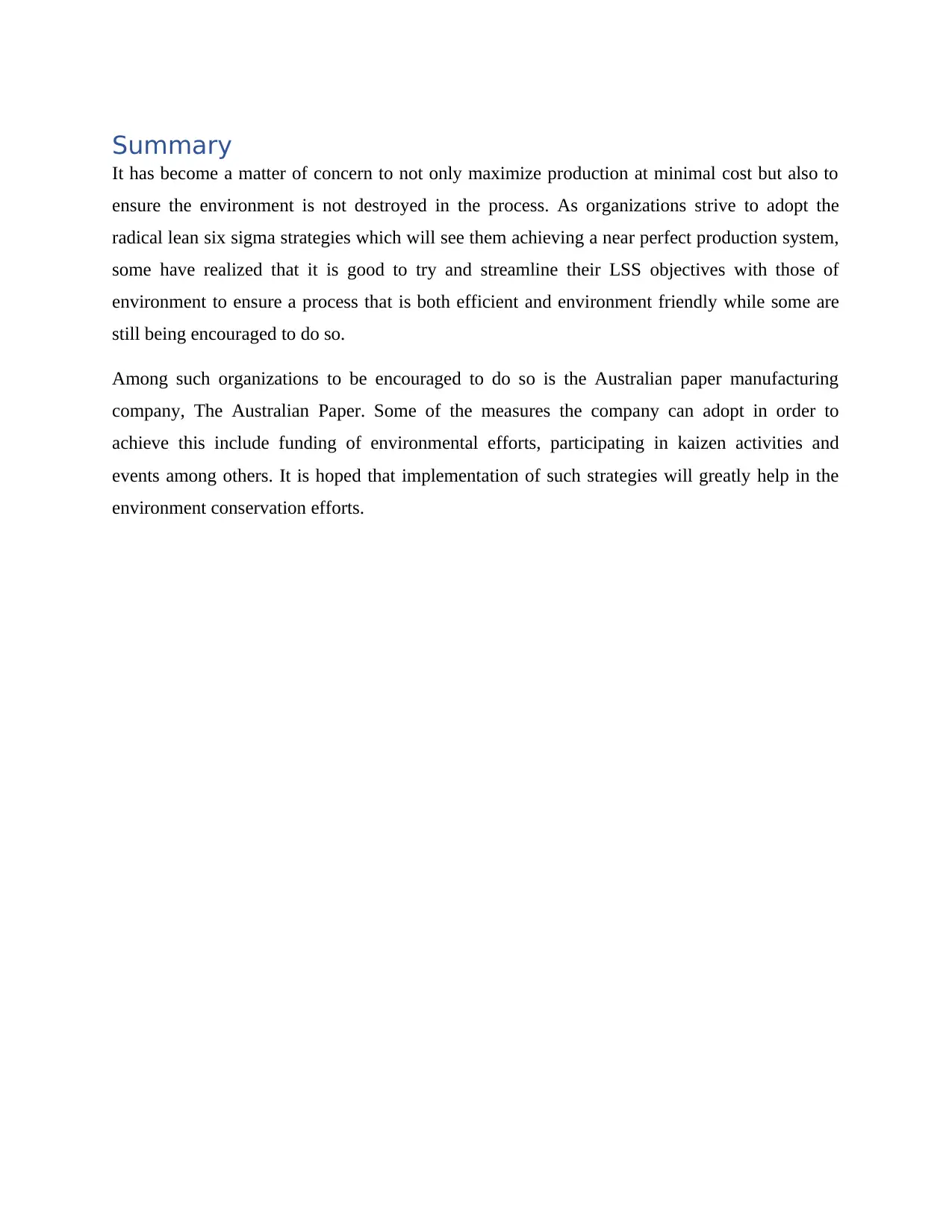
Summary
It has become a matter of concern to not only maximize production at minimal cost but also to
ensure the environment is not destroyed in the process. As organizations strive to adopt the
radical lean six sigma strategies which will see them achieving a near perfect production system,
some have realized that it is good to try and streamline their LSS objectives with those of
environment to ensure a process that is both efficient and environment friendly while some are
still being encouraged to do so.
Among such organizations to be encouraged to do so is the Australian paper manufacturing
company, The Australian Paper. Some of the measures the company can adopt in order to
achieve this include funding of environmental efforts, participating in kaizen activities and
events among others. It is hoped that implementation of such strategies will greatly help in the
environment conservation efforts.
It has become a matter of concern to not only maximize production at minimal cost but also to
ensure the environment is not destroyed in the process. As organizations strive to adopt the
radical lean six sigma strategies which will see them achieving a near perfect production system,
some have realized that it is good to try and streamline their LSS objectives with those of
environment to ensure a process that is both efficient and environment friendly while some are
still being encouraged to do so.
Among such organizations to be encouraged to do so is the Australian paper manufacturing
company, The Australian Paper. Some of the measures the company can adopt in order to
achieve this include funding of environmental efforts, participating in kaizen activities and
events among others. It is hoped that implementation of such strategies will greatly help in the
environment conservation efforts.
⊘ This is a preview!⊘
Do you want full access?
Subscribe today to unlock all pages.

Trusted by 1+ million students worldwide

Introduction
Lean and six sigma are two different action plans aimed at significantly enhancing a given
process. The phrase ‘Lean Six Sigma’ was coined in the 1990s and 2000s to describe the
combination of lean and Six Sigma philosophies to provide an integrated strategy for
business performance (Ruben, Vinodh, & Asokan, 2017). Lean six sigma is a systematic team
effort-based strategy seeking to ameliorate performance by eliminating waste and defects
(Pettersen, 2009). The defects in this context refer to seven kinds of wastes namely; Over-
production, waiting, non-utilized talents, transportation, inventory, motion and extra processing.
When lean six sigma concepts are successfully implemented, it will help the firm to reduce the
variation in process, reduce production lead time and help ensure the business progresses (Salah,
Rahim, & Carratero, 2010).
Lean refers to any method that assists in identifying and eliminating wastes in any given process
(Hilton & Sohal, 2012). Lean manufacturing refers to a systematic means with which waste is
minimized in a manufacturing system without causing a drop in productivity. Lean
manufacturing highlights what adds value by reducing everything else that does not add value
(Abdul, A, & Sulaima, 2013). From the consumer perspective, value is anything that the
consumer is willing to pay for (Forrester , Shimizu , & Soriano-Meier , 2010). Six Sigma on the
other hand refers to methods that are used in improving manufacturing processes. The
terminology was introduced by an engineer in Motorola in 1986. It is intended at recognizing and
removing causative agents of defect and variations in manufacturing and business processes. Six
Sigma has DMAIC (stands for define, measure, analyze, improve and control) phases that are
used in Lean Six Sigma (Assarlind, Gremyr, & Bäckman, 2012). It refers to a method for
improving, optimizing and stabilizing manufacturing and other business processes that is driven
by data. It is this combination of Lean and Six Sigma approaches that gives rise to Lean Six
Sigma strategy that seeks to achieve a perfectly efficient production system.
With the ever-increasing environmental degradation, the world over, it no longer suffices to only
focus on a perfect system where all wastes and defects as regards resources are eliminated. It has
become a matter of priority to try and arrest the situation before the world environment is
degraded beyond repair and rendered hostile and unfit for our very selves. Therefore, firms
should not only aim at implementing Lean Six Sigma strategies but do so with an aim to ensure
Lean and six sigma are two different action plans aimed at significantly enhancing a given
process. The phrase ‘Lean Six Sigma’ was coined in the 1990s and 2000s to describe the
combination of lean and Six Sigma philosophies to provide an integrated strategy for
business performance (Ruben, Vinodh, & Asokan, 2017). Lean six sigma is a systematic team
effort-based strategy seeking to ameliorate performance by eliminating waste and defects
(Pettersen, 2009). The defects in this context refer to seven kinds of wastes namely; Over-
production, waiting, non-utilized talents, transportation, inventory, motion and extra processing.
When lean six sigma concepts are successfully implemented, it will help the firm to reduce the
variation in process, reduce production lead time and help ensure the business progresses (Salah,
Rahim, & Carratero, 2010).
Lean refers to any method that assists in identifying and eliminating wastes in any given process
(Hilton & Sohal, 2012). Lean manufacturing refers to a systematic means with which waste is
minimized in a manufacturing system without causing a drop in productivity. Lean
manufacturing highlights what adds value by reducing everything else that does not add value
(Abdul, A, & Sulaima, 2013). From the consumer perspective, value is anything that the
consumer is willing to pay for (Forrester , Shimizu , & Soriano-Meier , 2010). Six Sigma on the
other hand refers to methods that are used in improving manufacturing processes. The
terminology was introduced by an engineer in Motorola in 1986. It is intended at recognizing and
removing causative agents of defect and variations in manufacturing and business processes. Six
Sigma has DMAIC (stands for define, measure, analyze, improve and control) phases that are
used in Lean Six Sigma (Assarlind, Gremyr, & Bäckman, 2012). It refers to a method for
improving, optimizing and stabilizing manufacturing and other business processes that is driven
by data. It is this combination of Lean and Six Sigma approaches that gives rise to Lean Six
Sigma strategy that seeks to achieve a perfectly efficient production system.
With the ever-increasing environmental degradation, the world over, it no longer suffices to only
focus on a perfect system where all wastes and defects as regards resources are eliminated. It has
become a matter of priority to try and arrest the situation before the world environment is
degraded beyond repair and rendered hostile and unfit for our very selves. Therefore, firms
should not only aim at implementing Lean Six Sigma strategies but do so with an aim to ensure
Paraphrase This Document
Need a fresh take? Get an instant paraphrase of this document with our AI Paraphraser
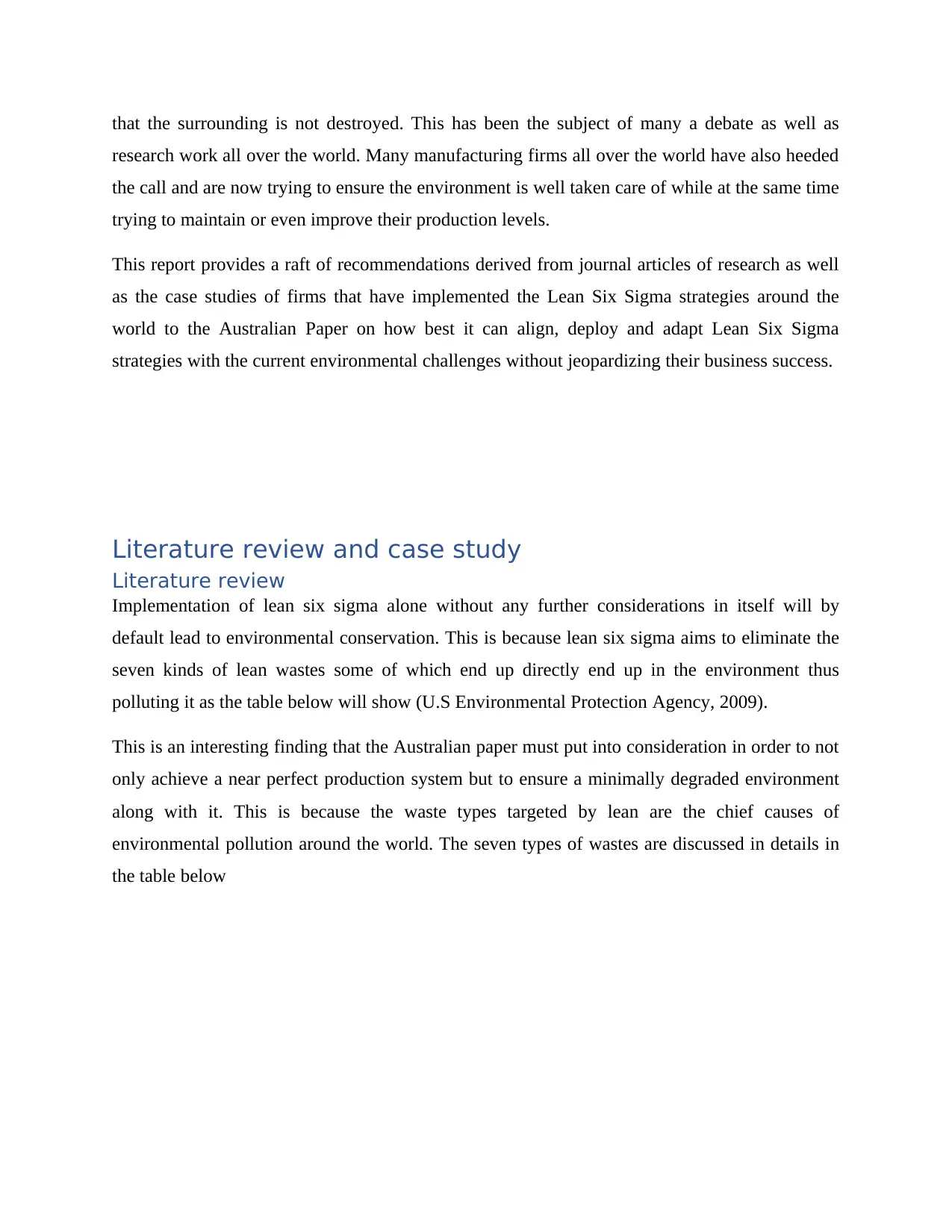
that the surrounding is not destroyed. This has been the subject of many a debate as well as
research work all over the world. Many manufacturing firms all over the world have also heeded
the call and are now trying to ensure the environment is well taken care of while at the same time
trying to maintain or even improve their production levels.
This report provides a raft of recommendations derived from journal articles of research as well
as the case studies of firms that have implemented the Lean Six Sigma strategies around the
world to the Australian Paper on how best it can align, deploy and adapt Lean Six Sigma
strategies with the current environmental challenges without jeopardizing their business success.
Literature review and case study
Literature review
Implementation of lean six sigma alone without any further considerations in itself will by
default lead to environmental conservation. This is because lean six sigma aims to eliminate the
seven kinds of lean wastes some of which end up directly end up in the environment thus
polluting it as the table below will show (U.S Environmental Protection Agency, 2009).
This is an interesting finding that the Australian paper must put into consideration in order to not
only achieve a near perfect production system but to ensure a minimally degraded environment
along with it. This is because the waste types targeted by lean are the chief causes of
environmental pollution around the world. The seven types of wastes are discussed in details in
the table below
research work all over the world. Many manufacturing firms all over the world have also heeded
the call and are now trying to ensure the environment is well taken care of while at the same time
trying to maintain or even improve their production levels.
This report provides a raft of recommendations derived from journal articles of research as well
as the case studies of firms that have implemented the Lean Six Sigma strategies around the
world to the Australian Paper on how best it can align, deploy and adapt Lean Six Sigma
strategies with the current environmental challenges without jeopardizing their business success.
Literature review and case study
Literature review
Implementation of lean six sigma alone without any further considerations in itself will by
default lead to environmental conservation. This is because lean six sigma aims to eliminate the
seven kinds of lean wastes some of which end up directly end up in the environment thus
polluting it as the table below will show (U.S Environmental Protection Agency, 2009).
This is an interesting finding that the Australian paper must put into consideration in order to not
only achieve a near perfect production system but to ensure a minimally degraded environment
along with it. This is because the waste types targeted by lean are the chief causes of
environmental pollution around the world. The seven types of wastes are discussed in details in
the table below
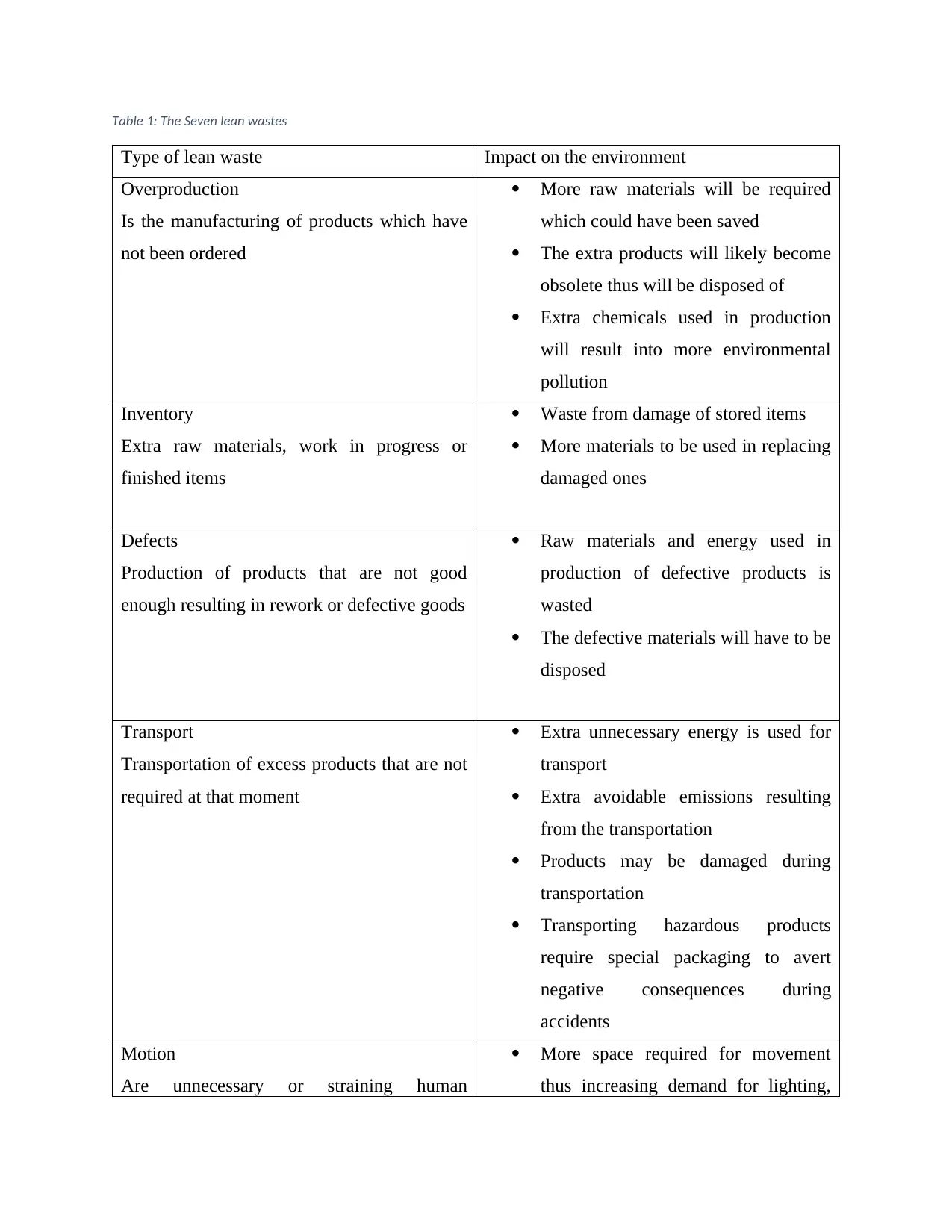
Table 1: The Seven lean wastes
Type of lean waste Impact on the environment
Overproduction
Is the manufacturing of products which have
not been ordered
More raw materials will be required
which could have been saved
The extra products will likely become
obsolete thus will be disposed of
Extra chemicals used in production
will result into more environmental
pollution
Inventory
Extra raw materials, work in progress or
finished items
Waste from damage of stored items
More materials to be used in replacing
damaged ones
Defects
Production of products that are not good
enough resulting in rework or defective goods
Raw materials and energy used in
production of defective products is
wasted
The defective materials will have to be
disposed
Transport
Transportation of excess products that are not
required at that moment
Extra unnecessary energy is used for
transport
Extra avoidable emissions resulting
from the transportation
Products may be damaged during
transportation
Transporting hazardous products
require special packaging to avert
negative consequences during
accidents
Motion
Are unnecessary or straining human
More space required for movement
thus increasing demand for lighting,
Type of lean waste Impact on the environment
Overproduction
Is the manufacturing of products which have
not been ordered
More raw materials will be required
which could have been saved
The extra products will likely become
obsolete thus will be disposed of
Extra chemicals used in production
will result into more environmental
pollution
Inventory
Extra raw materials, work in progress or
finished items
Waste from damage of stored items
More materials to be used in replacing
damaged ones
Defects
Production of products that are not good
enough resulting in rework or defective goods
Raw materials and energy used in
production of defective products is
wasted
The defective materials will have to be
disposed
Transport
Transportation of excess products that are not
required at that moment
Extra unnecessary energy is used for
transport
Extra avoidable emissions resulting
from the transportation
Products may be damaged during
transportation
Transporting hazardous products
require special packaging to avert
negative consequences during
accidents
Motion
Are unnecessary or straining human
More space required for movement
thus increasing demand for lighting,
⊘ This is a preview!⊘
Do you want full access?
Subscribe today to unlock all pages.

Trusted by 1+ million students worldwide
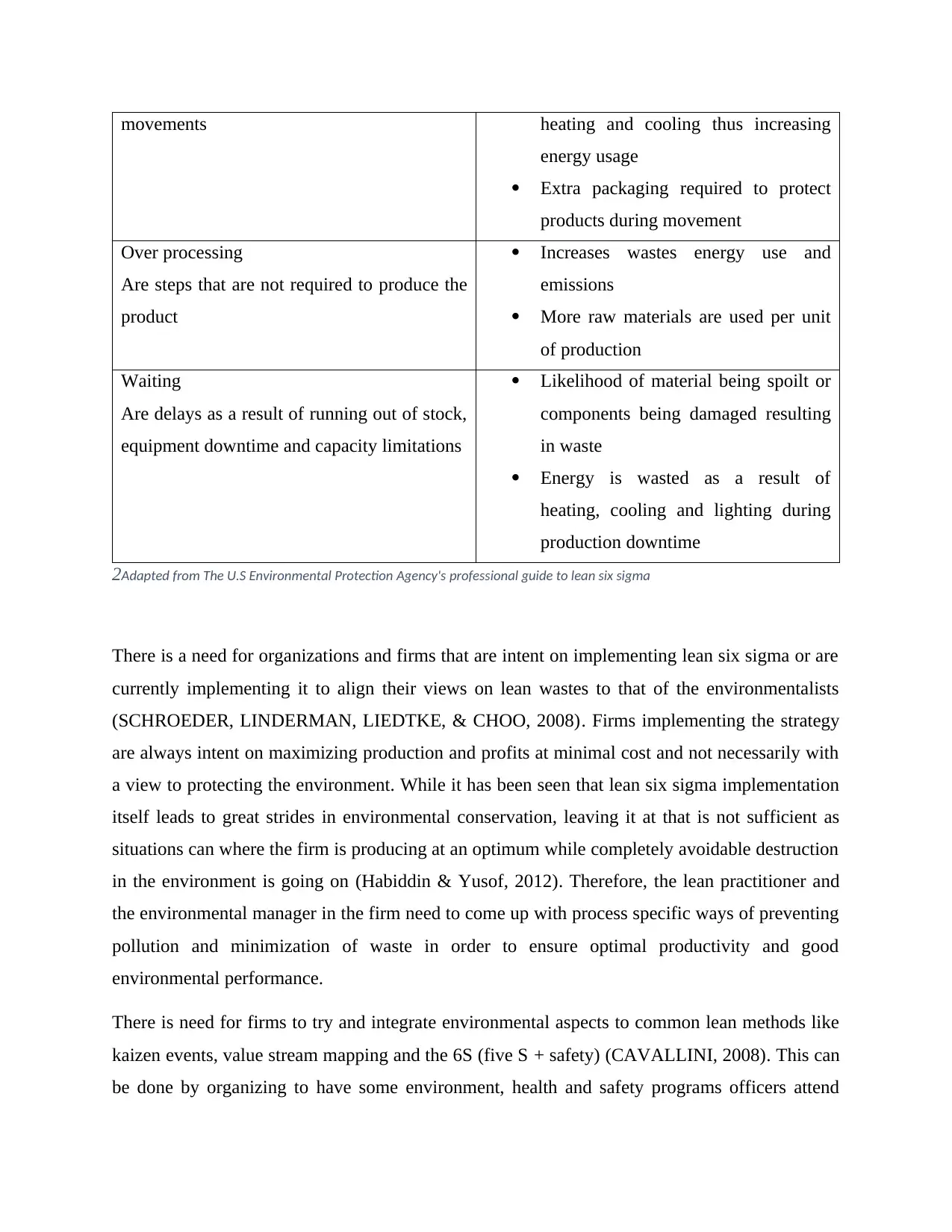
movements heating and cooling thus increasing
energy usage
Extra packaging required to protect
products during movement
Over processing
Are steps that are not required to produce the
product
Increases wastes energy use and
emissions
More raw materials are used per unit
of production
Waiting
Are delays as a result of running out of stock,
equipment downtime and capacity limitations
Likelihood of material being spoilt or
components being damaged resulting
in waste
Energy is wasted as a result of
heating, cooling and lighting during
production downtime
2Adapted from The U.S Environmental Protection Agency's professional guide to lean six sigma
There is a need for organizations and firms that are intent on implementing lean six sigma or are
currently implementing it to align their views on lean wastes to that of the environmentalists
(SCHROEDER, LINDERMAN, LIEDTKE, & CHOO, 2008). Firms implementing the strategy
are always intent on maximizing production and profits at minimal cost and not necessarily with
a view to protecting the environment. While it has been seen that lean six sigma implementation
itself leads to great strides in environmental conservation, leaving it at that is not sufficient as
situations can where the firm is producing at an optimum while completely avoidable destruction
in the environment is going on (Habiddin & Yusof, 2012). Therefore, the lean practitioner and
the environmental manager in the firm need to come up with process specific ways of preventing
pollution and minimization of waste in order to ensure optimal productivity and good
environmental performance.
There is need for firms to try and integrate environmental aspects to common lean methods like
kaizen events, value stream mapping and the 6S (five S + safety) (CAVALLINI, 2008). This can
be done by organizing to have some environment, health and safety programs officers attend
energy usage
Extra packaging required to protect
products during movement
Over processing
Are steps that are not required to produce the
product
Increases wastes energy use and
emissions
More raw materials are used per unit
of production
Waiting
Are delays as a result of running out of stock,
equipment downtime and capacity limitations
Likelihood of material being spoilt or
components being damaged resulting
in waste
Energy is wasted as a result of
heating, cooling and lighting during
production downtime
2Adapted from The U.S Environmental Protection Agency's professional guide to lean six sigma
There is a need for organizations and firms that are intent on implementing lean six sigma or are
currently implementing it to align their views on lean wastes to that of the environmentalists
(SCHROEDER, LINDERMAN, LIEDTKE, & CHOO, 2008). Firms implementing the strategy
are always intent on maximizing production and profits at minimal cost and not necessarily with
a view to protecting the environment. While it has been seen that lean six sigma implementation
itself leads to great strides in environmental conservation, leaving it at that is not sufficient as
situations can where the firm is producing at an optimum while completely avoidable destruction
in the environment is going on (Habiddin & Yusof, 2012). Therefore, the lean practitioner and
the environmental manager in the firm need to come up with process specific ways of preventing
pollution and minimization of waste in order to ensure optimal productivity and good
environmental performance.
There is need for firms to try and integrate environmental aspects to common lean methods like
kaizen events, value stream mapping and the 6S (five S + safety) (CAVALLINI, 2008). This can
be done by organizing to have some environment, health and safety programs officers attend
Paraphrase This Document
Need a fresh take? Get an instant paraphrase of this document with our AI Paraphraser
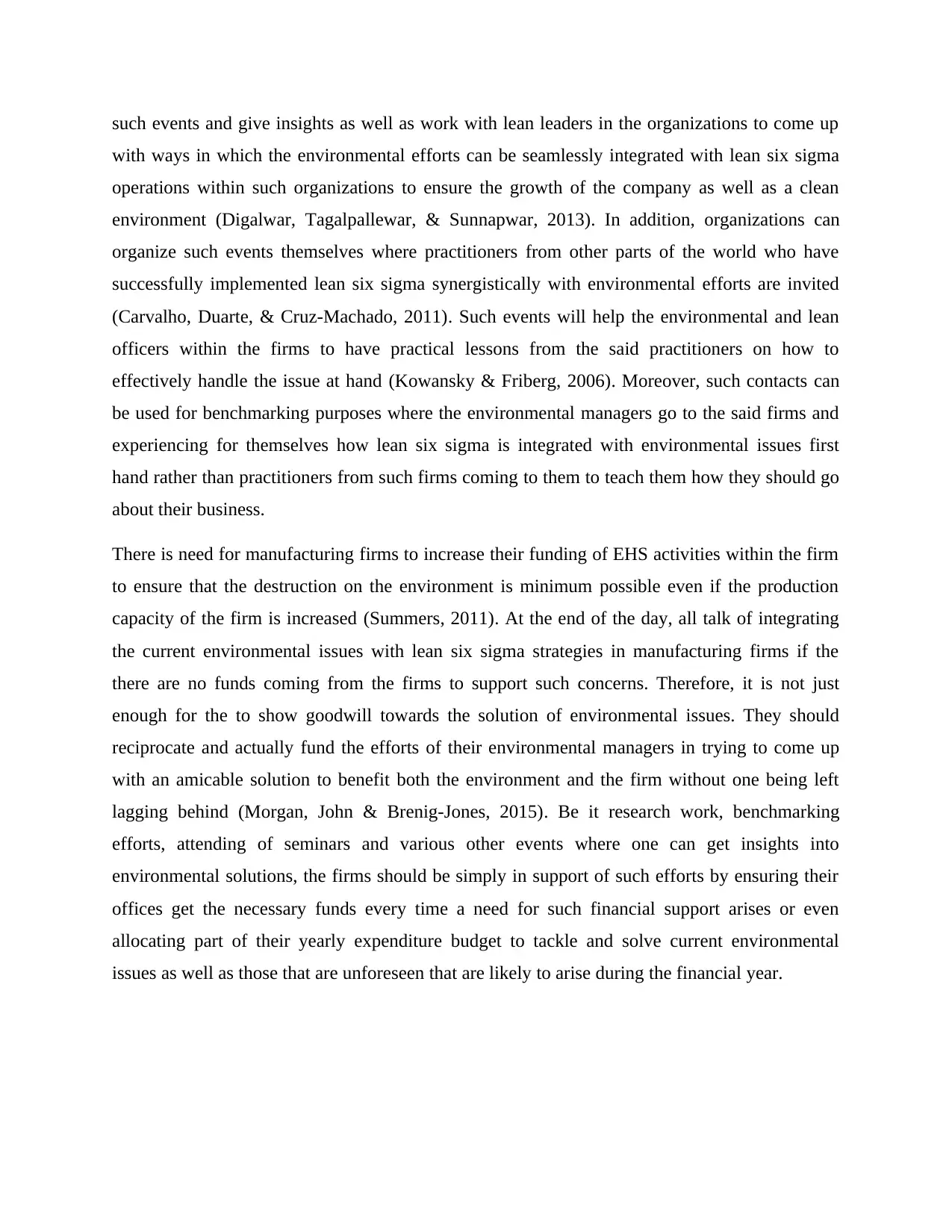
such events and give insights as well as work with lean leaders in the organizations to come up
with ways in which the environmental efforts can be seamlessly integrated with lean six sigma
operations within such organizations to ensure the growth of the company as well as a clean
environment (Digalwar, Tagalpallewar, & Sunnapwar, 2013). In addition, organizations can
organize such events themselves where practitioners from other parts of the world who have
successfully implemented lean six sigma synergistically with environmental efforts are invited
(Carvalho, Duarte, & Cruz-Machado, 2011). Such events will help the environmental and lean
officers within the firms to have practical lessons from the said practitioners on how to
effectively handle the issue at hand (Kowansky & Friberg, 2006). Moreover, such contacts can
be used for benchmarking purposes where the environmental managers go to the said firms and
experiencing for themselves how lean six sigma is integrated with environmental issues first
hand rather than practitioners from such firms coming to them to teach them how they should go
about their business.
There is need for manufacturing firms to increase their funding of EHS activities within the firm
to ensure that the destruction on the environment is minimum possible even if the production
capacity of the firm is increased (Summers, 2011). At the end of the day, all talk of integrating
the current environmental issues with lean six sigma strategies in manufacturing firms if the
there are no funds coming from the firms to support such concerns. Therefore, it is not just
enough for the to show goodwill towards the solution of environmental issues. They should
reciprocate and actually fund the efforts of their environmental managers in trying to come up
with an amicable solution to benefit both the environment and the firm without one being left
lagging behind (Morgan, John & Brenig-Jones, 2015). Be it research work, benchmarking
efforts, attending of seminars and various other events where one can get insights into
environmental solutions, the firms should be simply in support of such efforts by ensuring their
offices get the necessary funds every time a need for such financial support arises or even
allocating part of their yearly expenditure budget to tackle and solve current environmental
issues as well as those that are unforeseen that are likely to arise during the financial year.
with ways in which the environmental efforts can be seamlessly integrated with lean six sigma
operations within such organizations to ensure the growth of the company as well as a clean
environment (Digalwar, Tagalpallewar, & Sunnapwar, 2013). In addition, organizations can
organize such events themselves where practitioners from other parts of the world who have
successfully implemented lean six sigma synergistically with environmental efforts are invited
(Carvalho, Duarte, & Cruz-Machado, 2011). Such events will help the environmental and lean
officers within the firms to have practical lessons from the said practitioners on how to
effectively handle the issue at hand (Kowansky & Friberg, 2006). Moreover, such contacts can
be used for benchmarking purposes where the environmental managers go to the said firms and
experiencing for themselves how lean six sigma is integrated with environmental issues first
hand rather than practitioners from such firms coming to them to teach them how they should go
about their business.
There is need for manufacturing firms to increase their funding of EHS activities within the firm
to ensure that the destruction on the environment is minimum possible even if the production
capacity of the firm is increased (Summers, 2011). At the end of the day, all talk of integrating
the current environmental issues with lean six sigma strategies in manufacturing firms if the
there are no funds coming from the firms to support such concerns. Therefore, it is not just
enough for the to show goodwill towards the solution of environmental issues. They should
reciprocate and actually fund the efforts of their environmental managers in trying to come up
with an amicable solution to benefit both the environment and the firm without one being left
lagging behind (Morgan, John & Brenig-Jones, 2015). Be it research work, benchmarking
efforts, attending of seminars and various other events where one can get insights into
environmental solutions, the firms should be simply in support of such efforts by ensuring their
offices get the necessary funds every time a need for such financial support arises or even
allocating part of their yearly expenditure budget to tackle and solve current environmental
issues as well as those that are unforeseen that are likely to arise during the financial year.
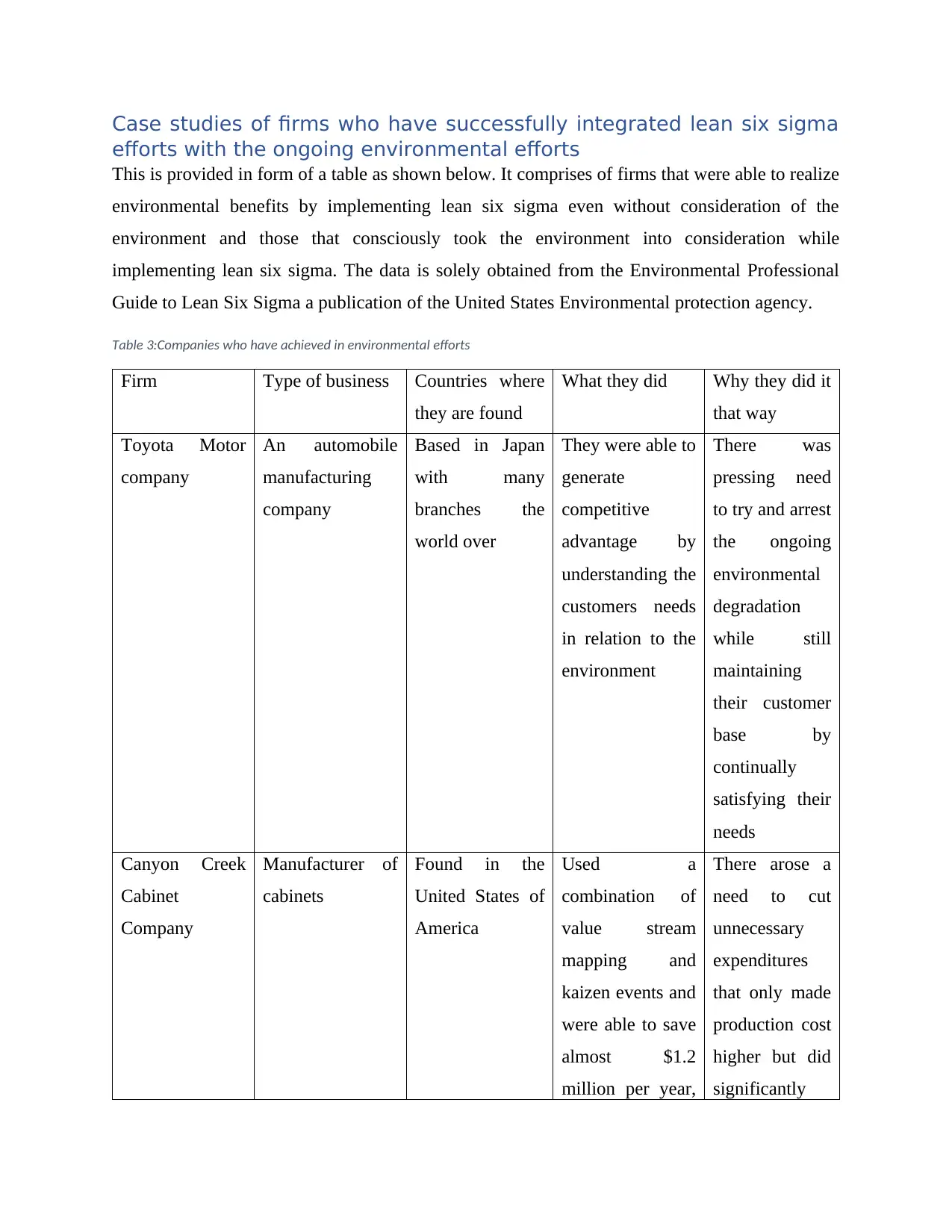
Case studies of firms who have successfully integrated lean six sigma
efforts with the ongoing environmental efforts
This is provided in form of a table as shown below. It comprises of firms that were able to realize
environmental benefits by implementing lean six sigma even without consideration of the
environment and those that consciously took the environment into consideration while
implementing lean six sigma. The data is solely obtained from the Environmental Professional
Guide to Lean Six Sigma a publication of the United States Environmental protection agency.
Table 3:Companies who have achieved in environmental efforts
Firm Type of business Countries where
they are found
What they did Why they did it
that way
Toyota Motor
company
An automobile
manufacturing
company
Based in Japan
with many
branches the
world over
They were able to
generate
competitive
advantage by
understanding the
customers needs
in relation to the
environment
There was
pressing need
to try and arrest
the ongoing
environmental
degradation
while still
maintaining
their customer
base by
continually
satisfying their
needs
Canyon Creek
Cabinet
Company
Manufacturer of
cabinets
Found in the
United States of
America
Used a
combination of
value stream
mapping and
kaizen events and
were able to save
almost $1.2
million per year,
There arose a
need to cut
unnecessary
expenditures
that only made
production cost
higher but did
significantly
efforts with the ongoing environmental efforts
This is provided in form of a table as shown below. It comprises of firms that were able to realize
environmental benefits by implementing lean six sigma even without consideration of the
environment and those that consciously took the environment into consideration while
implementing lean six sigma. The data is solely obtained from the Environmental Professional
Guide to Lean Six Sigma a publication of the United States Environmental protection agency.
Table 3:Companies who have achieved in environmental efforts
Firm Type of business Countries where
they are found
What they did Why they did it
that way
Toyota Motor
company
An automobile
manufacturing
company
Based in Japan
with many
branches the
world over
They were able to
generate
competitive
advantage by
understanding the
customers needs
in relation to the
environment
There was
pressing need
to try and arrest
the ongoing
environmental
degradation
while still
maintaining
their customer
base by
continually
satisfying their
needs
Canyon Creek
Cabinet
Company
Manufacturer of
cabinets
Found in the
United States of
America
Used a
combination of
value stream
mapping and
kaizen events and
were able to save
almost $1.2
million per year,
There arose a
need to cut
unnecessary
expenditures
that only made
production cost
higher but did
significantly
⊘ This is a preview!⊘
Do you want full access?
Subscribe today to unlock all pages.

Trusted by 1+ million students worldwide
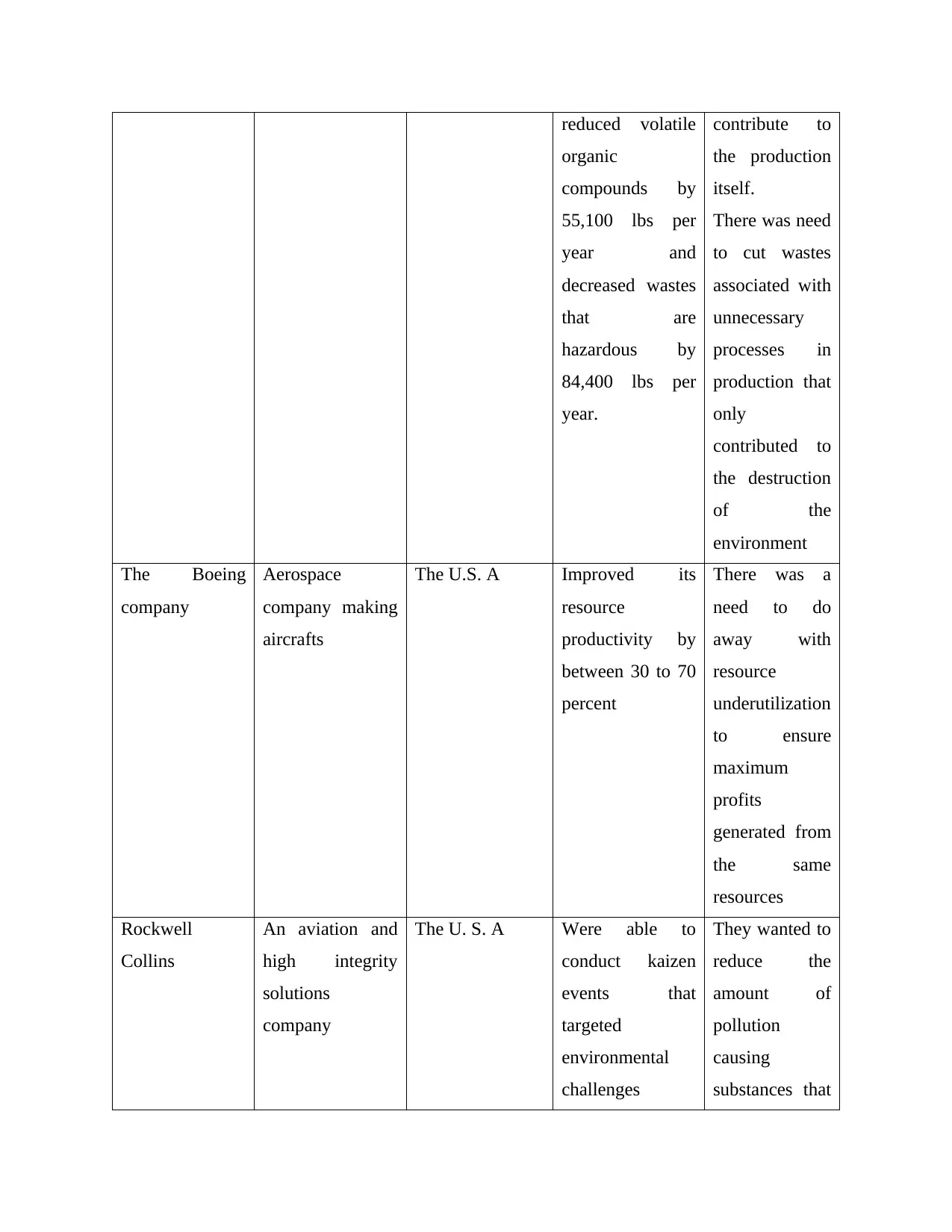
reduced volatile
organic
compounds by
55,100 lbs per
year and
decreased wastes
that are
hazardous by
84,400 lbs per
year.
contribute to
the production
itself.
There was need
to cut wastes
associated with
unnecessary
processes in
production that
only
contributed to
the destruction
of the
environment
The Boeing
company
Aerospace
company making
aircrafts
The U.S. A Improved its
resource
productivity by
between 30 to 70
percent
There was a
need to do
away with
resource
underutilization
to ensure
maximum
profits
generated from
the same
resources
Rockwell
Collins
An aviation and
high integrity
solutions
company
The U. S. A Were able to
conduct kaizen
events that
targeted
environmental
challenges
They wanted to
reduce the
amount of
pollution
causing
substances that
organic
compounds by
55,100 lbs per
year and
decreased wastes
that are
hazardous by
84,400 lbs per
year.
contribute to
the production
itself.
There was need
to cut wastes
associated with
unnecessary
processes in
production that
only
contributed to
the destruction
of the
environment
The Boeing
company
Aerospace
company making
aircrafts
The U.S. A Improved its
resource
productivity by
between 30 to 70
percent
There was a
need to do
away with
resource
underutilization
to ensure
maximum
profits
generated from
the same
resources
Rockwell
Collins
An aviation and
high integrity
solutions
company
The U. S. A Were able to
conduct kaizen
events that
targeted
environmental
challenges
They wanted to
reduce the
amount of
pollution
causing
substances that
Paraphrase This Document
Need a fresh take? Get an instant paraphrase of this document with our AI Paraphraser
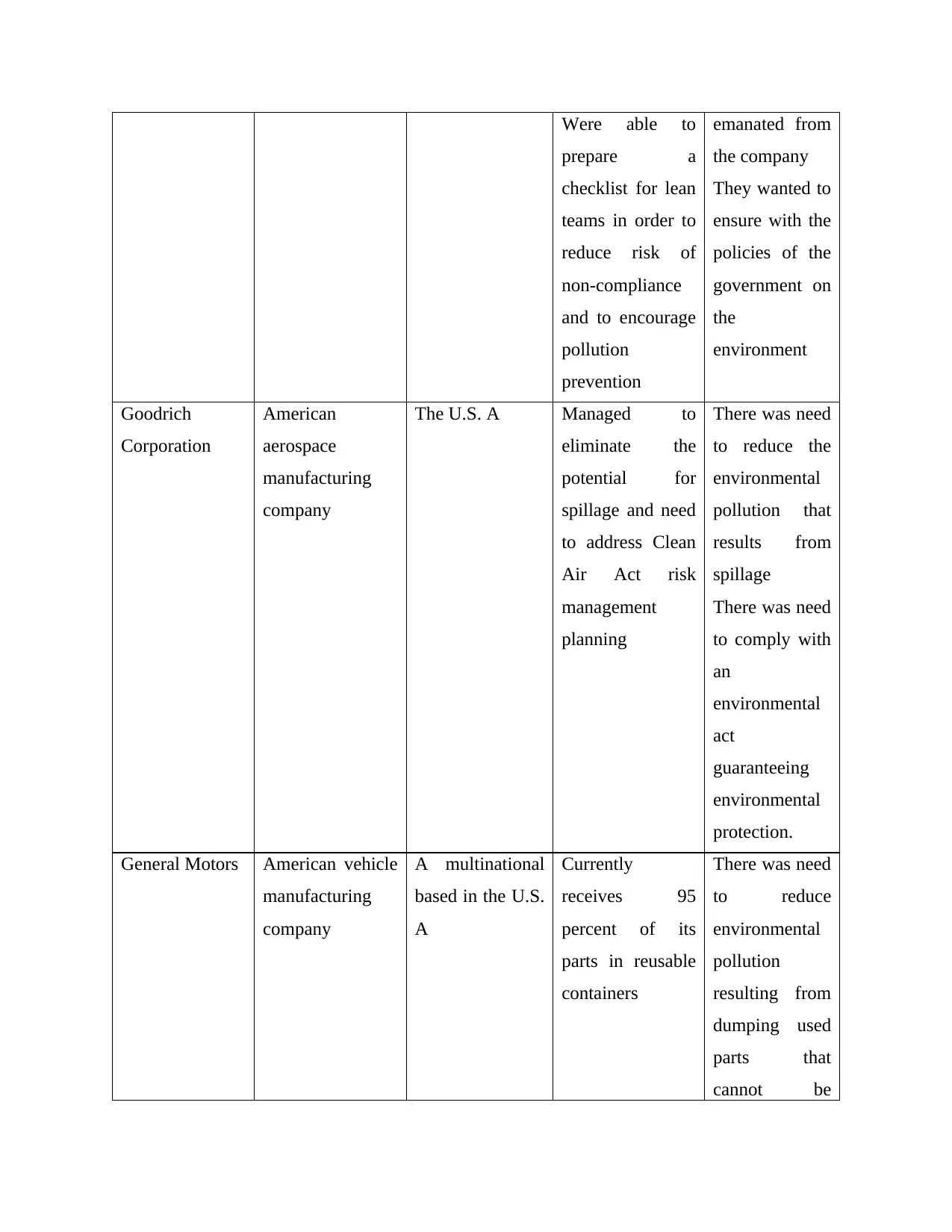
Were able to
prepare a
checklist for lean
teams in order to
reduce risk of
non-compliance
and to encourage
pollution
prevention
emanated from
the company
They wanted to
ensure with the
policies of the
government on
the
environment
Goodrich
Corporation
American
aerospace
manufacturing
company
The U.S. A Managed to
eliminate the
potential for
spillage and need
to address Clean
Air Act risk
management
planning
There was need
to reduce the
environmental
pollution that
results from
spillage
There was need
to comply with
an
environmental
act
guaranteeing
environmental
protection.
General Motors American vehicle
manufacturing
company
A multinational
based in the U.S.
A
Currently
receives 95
percent of its
parts in reusable
containers
There was need
to reduce
environmental
pollution
resulting from
dumping used
parts that
cannot be
prepare a
checklist for lean
teams in order to
reduce risk of
non-compliance
and to encourage
pollution
prevention
emanated from
the company
They wanted to
ensure with the
policies of the
government on
the
environment
Goodrich
Corporation
American
aerospace
manufacturing
company
The U.S. A Managed to
eliminate the
potential for
spillage and need
to address Clean
Air Act risk
management
planning
There was need
to reduce the
environmental
pollution that
results from
spillage
There was need
to comply with
an
environmental
act
guaranteeing
environmental
protection.
General Motors American vehicle
manufacturing
company
A multinational
based in the U.S.
A
Currently
receives 95
percent of its
parts in reusable
containers
There was need
to reduce
environmental
pollution
resulting from
dumping used
parts that
cannot be

reused or
recycled while
reusable
options were
available
4 Courtesy of U.S Environmental protection Agency
recycled while
reusable
options were
available
4 Courtesy of U.S Environmental protection Agency
⊘ This is a preview!⊘
Do you want full access?
Subscribe today to unlock all pages.

Trusted by 1+ million students worldwide
1 out of 21
Related Documents
Your All-in-One AI-Powered Toolkit for Academic Success.
+13062052269
info@desklib.com
Available 24*7 on WhatsApp / Email
![[object Object]](/_next/static/media/star-bottom.7253800d.svg)
Unlock your academic potential
Copyright © 2020–2025 A2Z Services. All Rights Reserved. Developed and managed by ZUCOL.



